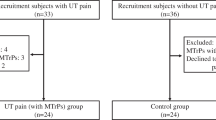Summary
In 11 patients, all women, 21–55 years of age, with unilateral work-related myalgia of the trapezius muscle, the right and left trapezius muscles were examined simultaneously for electromyogram (EMG) signs of localized muscle fatigue. All patients were tested with 0-kg hand load for 5 min, holding the arms straight at 90° of elevation in the scapular plane. Only 4 of the patients tolerated exposure to higher load levels. They were tested with 1 kg hand load for 3 min and 2 kg hand load for 2 min, with a period of rest of 30 min between the trials. The EMG mean power frequency (MPF) and root mean square (rms) were calculated. Data were normalized with the initial value as a reference and regression analyses were performed. On both sides a decrease of MPF and an increase of rms were found with increasing time and load, i.e. classical EMG signs of localized muscle fatigue. Compared with the nonaffected side smaller changes were found on the affected side, possibly due to pain inhibition, impaired microcirculation and biochemical changes along the muscle fibres. At 0-kg hand load we found no change of MPF on either side despite subjective feelings of fatigue and pain. We interpreted these findings as an indication of reduced capacity of the affected trapezius muscle to sustain static load with early development of pain-associated local fatigue.
Similar content being viewed by others
References
Altman DG, Gardner MJ (1989) Calculating confidence intervals for regression and correlation. In: Gardner MJ, Altman DG (eds) Statistics with confidence. BMJ, London
Arvidsson A (1982) A statistical method for detecting disturbances and non-stationary events in stochastic signals with special reference to data selection in EEG and EMG analysis. Technical Report no 126. Thesis, Chalmers University of Technology, Gothenburg
Basmajian J, Blumenstein R (1983) Electrode placement in electromyographic feedback. In: Basmajian J (ed) Biofeedback. Principles and practice for clinicians, 2nd edn. Williams and Wilkins, Baltimore
Basmajian JV, DeLuca CJ (1985) Muscles alive, 5th edn. Williams and Wilkins, Baltimore
Braakhekke JP, Stegeman DF, Joosten EMG (1989) Increase in median power frequency of the surface electromyogram in biceps brachii with increasing force during fatigue. Electroencephalogr Clin Neurophysiol 73:151–156
Byström S, Sjøgaard G (1991) Potassium homeostasis during and following exhaustive submaximal static handgrip contractions. Acta Physiol Scand 142:59–66
Chaffin DB (1973) Localized muscle fatigue — definition and measurement. J Occup Med 15:346–354
DeLuca CJ (1984) Myoelectrical manifestations of localized muscle fatigue in humans. CRC Crit Rev Biomed Eng 11:251–279
DeLuca CJ, Knaflitz M (1990) Surface electromyography. What's new? Neuromuscular Research Center, Boston University, Boston, Mass.
Draper N, Smith H (1981) Applied regression analysis, 2nd edn. Wiley, New York
Hagberg M (1981) Electromyographic signs of muscle fatigue in two elevated arm positions. Am J Phys Med 60:111–121
Hagberg M, Kvarnström S (1984) Muscular endurance and electromyographic fatigue in myofascial shoulder pain. Arch Phys Med Rehabil 65:522–525
Hagberg M, Wegman DH (1987) Prevalence rates and odds ratios of shoulder-neck diseases in different occupational groups. Br J Ind Med 44:602–610
Hagberg C, Hagberg M (1989a) Surface amplitude and frequency dependence on exerted force for the upper trapezius muscle: a comparison between right and left sides. Eur J Appl Physiol 58:641–645
Hagberg C, Hagberg M (1989b) Muscular tenderness evaluated by surface EMG frequency analysis of isometric contractions. Scand J Dent Res 97:368–374
Johnston TB (1937) The movements of the shoulder joint. A plea for the use of the “Plane of the scapula” as the plane of reference for movements at the humeroscapular joint. Br J Surg 25:252–260
Kadefors R, Kaiser E, Petersén I (1968) Dynamic spectrum analysis of myo-potentials with special reference to muscle fatigue. Electromyography 8:39–74
Kadefors R, Kaiser E, Petersén I (1969) Dynamic frequency analysis in neurogenic and myogenic parese. Electroencephalogr Clin Neurophysiol 26:343–343
Kadefors R, Arvidsson A, Herberts P, Petersén I (1983) EMG data processing in ergonomics, with special emphasis on studies of shoulder muscle load. Computer-aided electromyography. Prog Clin Neurophysiol 10:273–286
Kelly D (1985) Central representations of pain and analgesia. In: Kandel ER, Schwartz JH (eds) Principles of neural science, 2nd edn. Elsevier, New York, pp 331–343
Kleinbaum DG, Kupper LL, Muller KE (1988) Applied regression analysis and other multivariable methods, 2nd edn. PWS-Kent, Boston
Kogi K, Hakamada T (1962) Frequency analysis of the surface electromyogram in muscle fatigue. J Sci Labour (Tokyo) 38:519–528
Kuorinka I (1976) Assessment of muscular fatigue with the spectral analysis of myoelectric potentials. Thesis, University of Helsinki, ISBN 951-801-026-9
Kvarnström S (1983) Occurrence of musculoskeletal disorders in a manufacturing industry, with special reference to occupational shoulder disorders. Scand J Rehabil Med [Suppl] 8:1–114
Larsson S-E, Bengtsson A, Bodegård L, Henriksson K-G, Larsson J (1988) Muscle changes in work-related chronic myalgia. Acta Orthop Scand 59:552–556
Larsson S-E, Bodegard L, Henriksson KG, Öberg PÅ (1990) Chronic trapezius myalgia. Morphology and blood flow studied in 17 patients. Acta Orthop Scand 61:394–398
Lindström L, Magnusson R, Petersén I (1970) Muscular fatigue and action potential conduction velocity changes studied with frequency analysis of EMG signals. Electromyography 4:341–356
Lindström L, Magnusson R, Petersén I (1974) Muscle load influence on myoelectric signal characteristics. Scand J Rehabil Med [Suppl] 3:127–148
Linssen HJP, Jacobs M, Stegeman DF, Joosten EMG, Moleman J (1990) Muscle fatigue in McArdle's disease. Muscle fibre conduction velocity spectrum during ischemic exercise. Brain 113:1779–1793
Mills KR, Newham DJ, Edwards RHT (1984) Muscle pain. In: Wall PD, Melzack R (eds) Textbook of pain. Churchill Livingstone, Edinburgh, pp 319–330
Neter J, Wasserman J, Kutner MH (1989) Applied linear regression models, 2nd edn. Irwin, Homewood, Ill.
Öberg T, Sandsjö L, Kadefors R (1990) Electromyogram mean power frequency in non-fatigued trapezius muscle. Eur J Appl Physiol 61:363–369
Öberg T, Sandsjö L, Kadefors R (1991) Variability of the EMG mean power frequency: a study on the trapezius muscle. J Electromyogr Kinesiol 1:237–243
Öberg T, Sandsjö L, Kadefors R (1992) Arm movement and EMG mean power frequency in the trapezius muscle: a comparison between surface and intramuscular techniques. Electromyogr Clin Neurophysiol 32:87–96
Petrofsky JS, Glaser RM, Phillips CA (1982) Evaluation of the amplitude and frequency components of the surface EMG as an index of muscle fatigue. Ergonomics 25:213–223
Rønager G, Christensen H, Fuglsang-Fredriksen A (1989) Power spectrum analysis of the EMG pattern in normal and diseased muscle. J Neurol Sci 94:283–294
Sjøgaard G (1986a) Intramuscular changes during long-term contraction. In: Corlett N, Wilson J, Manenica I (eds) The ergonomics of working postures. Taylor and Francis, London, pp 136–143
Sjøgaard G (1986b) Water and electrolyte fluxes during exercise and their relation to muscle fatigue. Acta Physiol Scand [Suppl] 556:129–136
Sjøgaard G (1988) Muscle energy metabolism and electrolyte shifts during low-level prolonged static contraction in man. Acta Physiol Scand 134:181–187
Sjøgaard G (1991) Role of exercise-induced potassium fluxes underlying muscle fatigue: a brief review. Can J Physiol Pharmacol 69:238–245
Sjøgaard G, Savard G, Juel C (1988) Muscle blood flow during isometric activity and its relation to muscle fatigue. Eur J Appl Physiol 57:327–335
Stulen FB, DeLuca CJ (1978) The relation between the myoelectric signal and physiological properties of constant force contractions. Electroencephalogr Clin Neurophysiol 45:681–698
Suurküla J, Hägg G (1987) Relations between shoulder/neck disorders and EMG zero crossing shifts in female assembly workers using the test contraction method. Ergonomics 11:1553–1564
Viitasalo JHT, Komi PV (1977) Signal characteristics of EMG during fatigue. Eur J Appl Physiol 37:111–121
Author information
Authors and Affiliations
Rights and permissions
About this article
Cite this article
Öberg, T., Sandsjö, L., Kadefors, R. et al. Electromyographic changes in work-related myalgia of the trapezius muscle. Europ. J. Appl. Physiol. 65, 251–257 (1992). https://doi.org/10.1007/BF00705090
Accepted:
Issue Date:
DOI: https://doi.org/10.1007/BF00705090




